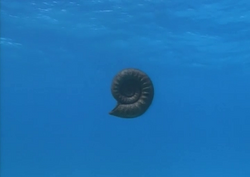
Ammonites are an extinct group of invertebrate marine animals of the subclass Ammonoidea in the class Cephalopoda, phylum Mollusca. They are excellent index fossils, and it is often possible to link the rock layer in which they are found to specific geological time periods.
Ammonites' closest living relative is probably not the modern Nautilus (which they outwardly resemble), but rather the subclass Coleoidea (octopus, squid, and cuttlefish). (The Giant Orthocone, featured in Sea Monsters, was also an extinct cephalopod, but it wasn't a close relative.) The belemnites, who shared the Mesozoic seas was the ammonites, also belonged to a different suborder from them.
Their fossil shells usually take the form of planispirals, although there were some helically-spiraled and non-spiraled forms (known as "heteromorphs"). Their name came from their spiral shape as their fossilized shells somewhat resemble tightly-coiled rams' horns. Pliny the Elder (d. 79 A.D. near Pompeii in an explosion) called fossils of these animals ammonis cornua ("horns of Ammon") because the Egyptian god Ammon (Amun) was typically depicted wearing ram's horns. Often the name of an ammonite genus ends in -ceras, which is Greek (κέρας) for "horn" (for instance, Pleuroceras).
Incidentally, though all ammonites had curling shells that made them the fossil icons of the modern times, these shells were very different - some were small and plain, others massive and very ornate, with whorls, ridges, lumps, bumps, and so on.
Originating from within the bactritoid nautiloids, the ammonoid cephalopods first appeared in the Late Silurian to Early Devonian (circa 400 MYA) and became extinct at the close of the Cretaceous (65 MYA) along with the dinosaurs. The classification of ammonoids is based in part on the ornamentation and structure of the septa comprising their shells' gas chambers; by these and other characteristics we can divide subclass Ammonoidea into three orders and eight known suborders. While nearly all nautiloids show gently curving sutures, the ammonoid suture line (the intersection of the septum with the outer shell) was folded, forming saddles (or peaks) and lobes (or valleys).
Ammonites were hunters, but not very active ones - most of their time was spent floating via the current, or swimming at slow speed. This limited the kind of food they could catch - they probably fed on slow-moving crustaceans, such as crabs and lobsters, or other slow swimmers, such as Jellyfish. The ammonites would catch prey with their tentacles and tear it into pieces with their parrot-like beaks, just as the modern nautiloids do.
The ammonites themselves were an important part of diet for many hunters. They were eaten by sharks, plesiosaurs, ichthyosaurs, mosasaurs and many other sea animals. Aside from their shells, ammonites had no means of protection, though some had ridges or small spines, either to strengthen the shell or make it harder to bite through. Nevertheless, even if the predator failed to kill the ammonite with its bite, it would still puncture its' shell, making the mollusk unable to float and causing it to sink to the sea floor.
The fossil remains of ammonites are abundant, just as the remains of trilobites are. They were successful until the very end of the Cretaceous, when they began to steeply decline, and the K-T extinction destroyed them for good.
In Walking with Dinosaurs
Ammonites were shown in third episode of Walking with Dinosaurs. A juvenile Ophthalmosaurus unsuccessfully harassed one of them, but was unable to bite through its' shell.
